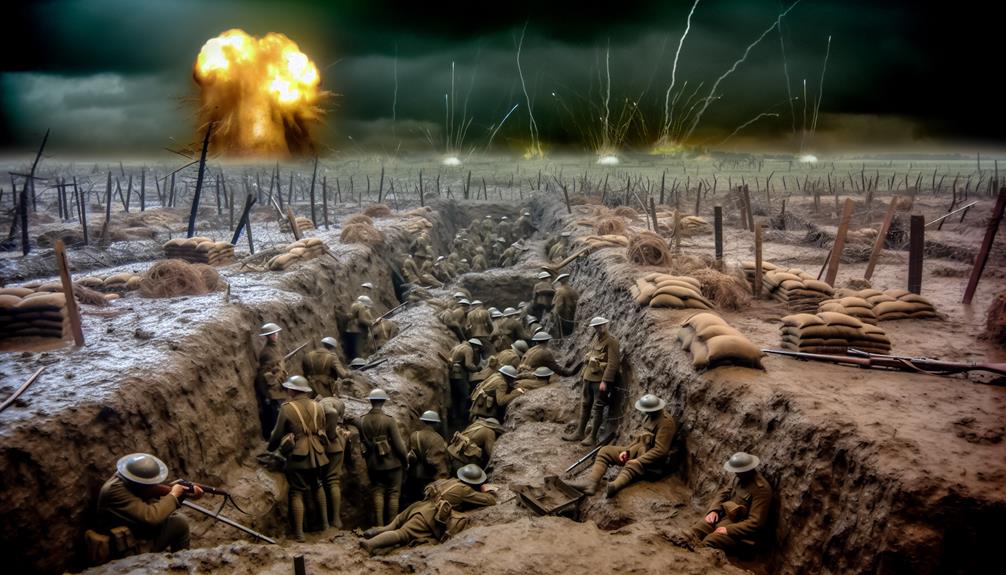The Battle of the Somme, etched into the annals of World War I history, reveals a harrowing narrative of strategic ambitions entangled with unprecedented human sacrifice. As the conflict unfolded, the meticulously laid plans collided with the harsh reality of trench warfare, resulting in a catastrophic toll on life and a haunting deadlock. Amidst the chaos, the introduction of innovative military technologies added a layer of complexity to an already grim landscape. The repercussions of this blood-soaked battleground echoed far beyond the fields of battle, shaping the course of the war and leaving a lasting imprint on the collective memory of nations involved.
Key Takeaways
- The Battle of the Somme resulted in astronomical casualties and immense physical and psychological trauma.
- Families and communities were deeply affected by the staggering loss of life and the mourning of loved ones.
- The battle highlighted the need for strategic changes in military tactics due to the heavy toll on soldiers.
- It reshaped national identities and left lasting historical lessons about the consequences of war.
- The Battle of the Somme significantly impacted the overall war effort, weakening the Central Powers.
Origins of the Battle
The origins of the Battle of the Somme can be traced back to the strategic military planning of the Allied forces during World War I. Several causes led to the decision to launch this massive offensive. One significant reason was the need to relieve pressure on the French forces at Verdun, where they were engaged in a brutal battle with the Germans. By launching an offensive at the Somme, the Allies aimed to divert German troops and resources away from Verdun, easing the strain on the French army.
Furthermore, the Allied commanders devised strategies to break through the formidable German defenses along the Western Front. They planned a massive bombardment of the German positions to weaken their defenses and destroy barbed wire obstacles. This bombardment was meant to pave the way for a successful infantry advance. The strategies also involved a coordinated attack involving British and French forces along a wide front, aiming to achieve a breakthrough and exploit any weaknesses in the German lines.
Preparations and Planning
Amidst the strategic motivations driving the Allies' decision to launch the Battle of the Somme, meticulous preparations and planning were undertaken to guarantee the success of the upcoming offensive. The strategic tactics employed by the Allies focused on achieving a breakthrough on the Western Front, intending to relieve pressure on the French forces at Verdun and to weaken the German army. This required extensive planning to make certain coordination among the British and French forces involved in the operation.
Logistical challenges loomed large during the preparations for the Battle of the Somme. The sheer scale of the offensive necessitated careful organization of men, equipment, and supplies. The Allies faced the challenging task of amassing troops, artillery, ammunition, and provisions for an operation of unprecedented magnitude. Supply lines had to be established and protected to sustain the troops once the offensive began. Additionally, communication systems needed to be improved to facilitate coordination between different units on the battlefield.
To address these challenges, detailed plans were drawn up to streamline the movement of troops and equipment, optimize the deployment of artillery, and ensure a continuous flow of supplies to the front lines. The success of the upcoming offensive hinged on the effective execution of these plans, emphasizing the critical role that meticulous preparations and planning played in the lead-up to the Battle of the Somme.
Launch and Initial Offensives
Detailed analysis of the launch and initial offensives at the Battle of the Somme reveals strategic decisions and tactical maneuvers that shaped the course of the conflict. The Battle of the Somme, which began on July 1, 1916, marked a significant turning point in World War I. The primary strategy behind the offensive was to relieve pressure on the French forces at Verdun by launching a massive joint British and French attack along a 25-mile front. The strategic objectives of this offensive were to break through the German lines, advance into enemy territory, and ultimately achieve a decisive victory.
Trench warfare dominated the battlefield during the initial stages of the Battle of the Somme. The British and French forces faced entrenched German defenders, leading to a brutal and protracted conflict characterized by heavy casualties on both sides. The opening day of the battle, in particular, stands out as one of the bloodiest in the history of warfare, with tens of thousands of soldiers killed or wounded.
Despite the high cost in human lives, the launch and initial offensives at the Battle of the Somme showcased the resilience and determination of the Allied forces. The tactical decisions made during this phase of the battle set the stage for the grueling attritional warfare that would characterize the conflict on the Western Front for the next two years.
The Devastating Casualties
With staggering numbers reflecting the somber reality of war, the casualties incurred during the Battle of the Somme underscore the immense human cost of the conflict. The devastating casualties experienced during this brutal battle left an indelible mark on history, shaping the way we perceive the sacrifices made during wartime. The human cost of the Battle of the Somme extended far beyond mere numbers, delving deep into the psychological impact it had on individuals and communities.
- Loss of Life: The Battle of the Somme resulted in an astronomical loss of life on both sides, with soldiers falling in staggering numbers across the battlefield.
- Wounded Soldiers: The wounded soldiers faced immense physical and psychological trauma, enduring pain and suffering that would last long after the battle ended.
- Families Torn Apart: The casualties at the Somme tore families apart, leaving behind grieving parents, spouses, and children who had to cope with the devastating loss of their loved ones.
- Impact on Communities: The battle had a profound impact on communities, with villages and towns mourning the loss of a generation of young men who never returned home.
- Long-Term Consequences: The casualties of the Battle of the Somme reverberated for years to come, shaping the collective memory of nations and highlighting the true cost of war.
Challenges and Setbacks
The challenges and setbacks encountered during the Battle of the Somme revealed the harsh realities faced by the military forces on both sides as they grappled with strategic difficulties and unforeseen obstacles. One of the key issues that plagued the Allied forces was strategic errors in planning and execution. The initial bombardment intended to weaken German defenses fell short of expectations, allowing the enemy to maintain a significant defensive capability. This strategic error resulted in the failure to achieve a swift breakthrough, prolonging the conflict and escalating casualties.
Logistical problems further compounded the challenges faced during the Battle of the Somme. The sheer scale of the offensive, coupled with the difficult terrain and adverse weather conditions, strained supply lines and hindered troop movements. Inadequate transportation infrastructure made it difficult to quickly reinforce troops at the front lines, leaving units vulnerable to counterattacks and weakening overall combat effectiveness.
The challenges and setbacks experienced during the Battle of the Somme underscored the complexities of modern warfare and the high cost of strategic miscalculations. The lessons learned from these difficulties would shape future military operations and emphasize the importance of meticulous planning, coordination, and adaptability in the face of adversity.
Role of New Military Technology
Emerging military technologies played a pivotal role in reshaping the dynamics of the Battle of the Somme during World War I, influencing strategy, tactics, and outcomes on the battlefield. Two key advancements stood out during this brutal conflict:
- Impact of Artillery: The Battle of the Somme witnessed a significant evolution in artillery tactics. Heavy artillery bombardments were used to soften enemy defenses before infantry assaults. The sheer volume and intensity of artillery fire caused massive destruction, creating chaos and disrupting enemy lines. However, despite its critical power, artillery alone was not always sufficient to achieve decisive victories.
- Development of Tanks: The introduction of tanks marked a revolutionary moment in military history. At the Battle of the Somme, the British deployed tanks for the first time in a major offensive. These armored vehicles provided vital firepower, protection for infantry, and the ability to traverse difficult terrain. While early tanks were slow and prone to mechanical failures, they nonetheless represented a significant step forward in modern warfare.
These technological advancements had a profound impact on the Battle of the Somme, influencing tactics, strategies, and the overall conduct of the war. The implementation of new military technologies reflected the ongoing evolution of warfare during World War I, shaping the nature of conflicts for years to come.
Impact on Allied and Central Powers
The utilization of new military technologies at the Battle of the Somme greatly altered the strategic landscape for both the Allied and Central Powers in World War I. The impact of the battle on the Allied Powers was marked by significant triumphs. The British and French forces, despite the heavy casualties suffered, managed to advance and capture key positions, albeit at a high cost. The use of creeping barrages and improved artillery tactics allowed the Allies to make some territorial gains, albeit modest in comparison to the overall objective.
Conversely, the Central Powers, primarily represented by the German forces, faced substantial losses and strategic setbacks. The intensity of the battle, coupled with the relentless Allied assaults, strained the German military capabilities and resources. The German army, already engaged on multiple fronts, found it challenging to reinforce its positions at the Somme adequately. The attrition suffered by the Central Powers during the battle weakened their overall war effort and further stretched their already limited resources.
Legacy and Historical Significance
The aftermath of the Battle of the Somme reverberates through history as a pivotal moment that left a profound mark on the course of World War I and the subsequent global conflicts that followed. The legacy and historical significance of this brutal battle continue to impact today, influencing various aspects of society and warfare.
- Remembrance Ceremonies: Each year, remembrance ceremonies are held to honor the soldiers who fought and died during the Battle of the Somme. These ceremonies serve as a reminder of the sacrifices made and the horrors of war.
- Military Tactics: The Battle of the Somme highlighted the need for strategic changes in military tactics, leading to the development of new approaches to warfare and emphasizing the importance of proper planning and coordination.
- Casualties: The staggering number of casualties suffered by both sides during the battle underscored the human cost of war and prompted a reevaluation of military strategies to minimize losses in future conflicts.
- National Identity: The Battle of the Somme played a significant role in shaping the national identities of the countries involved, fostering a sense of patriotism and unity among the troops and civilians.
- Historical Lessons: Studying the Battle of the Somme provides valuable historical lessons on the consequences of war, highlighting the need for diplomacy, cooperation, and peace-building efforts to prevent similar conflicts in the future.
Analysis of Tactics Used
Strategic maneuvers employed during the Battle of the Somme showcased a complex interplay of tactical decisions and logistical challenges that shaped the course and outcomes of the conflict. The battle, which began on July 1, 1916, saw a mix of tactical innovations and strategic blunders that had a profound impact on the battlefield.
One of the tactical innovations introduced during the Battle of the Somme was the creeping barrage. This artillery tactic involved a curtain of fire that moved slowly ahead of the infantry, providing them with cover and suppressing enemy defenses. The creeping barrage was effective in some instances, allowing the infantry to advance, but it also had its drawbacks, such as the risk of friendly fire or the barrage moving too quickly, leaving soldiers vulnerable.
However, despite some tactical advancements, there were significant strategic blunders that plagued the Battle of the Somme. One such blunder was the lack of coordination between the British and French forces. This lack of unity in command led to disjointed offensives and communication failures, ultimately hindering the overall progress of the battle.
Remembering the Fallen
In commemorating the sacrifices made during the Battle of the Somme, it is essential to honor the memory of the fallen soldiers with solemn reverence and historical reflection. The soldiers who fought in this brutal battle displayed immense courage and resilience in the face of unimaginable horrors, and their sacrifice should never be forgotten. Through various means such as memorial ceremonies and educational initiatives, we can guarantee that the memory of these brave individuals lives on for future generations to appreciate and learn from.
- Honoring Sacrifice: It is vital to acknowledge the tremendous sacrifices made by the soldiers who fought in the Battle of the Somme, recognizing the hardships they endured and the ultimate price they paid for their service.
- Memorial Ceremonies: Organizing solemn memorial ceremonies allows us to come together as a community to pay our respects to the fallen soldiers, providing a space for collective mourning and reflection.
- Educational Programs: Implementing educational programs that focus on the history of the Battle of the Somme helps to ensure that the memory of the fallen soldiers remains alive in the public consciousness.
- Cemetery Visits: Visiting the cemeteries where the soldiers are laid to rest can be a powerful way to connect with the past and to show respect for the individuals who gave their lives in the line of duty.
- Remembrance Activities: Engaging in remembrance activities such as moments of silence or symbolic gestures serves as a poignant reminder of the sacrifices made during the Battle of the Somme and throughout World War I.
Frequently Asked Questions
How Did the Soldiers Cope With the Psychological Trauma After the Battle?
After enduring the horrors of battle, soldiers often grapple with profound psychological trauma. Post-traumatic stress disorder (PTSD) treatment and mental health support are essential in helping them cope.
Through counseling, therapy, and medication, soldiers can address their trauma, manage their symptoms, and work towards healing. Access to these resources is paramount in supporting the mental well-being of those who have served in combat.
What Provisions Were Made for Wounded Soldiers During the Battle?
During the Battle of the Somme, provisions for wounded soldiers included medical care stations set up in the rear areas, closer to the front lines, to guarantee prompt treatment.
Trench conditions posed challenges for medical personnel due to limited resources and the constant threat of enemy fire.
Despite these obstacles, efforts were made to evacuate the wounded swiftly to field hospitals for more extensive care, showcasing a commitment to providing aid in the midst of intense combat.
Were There Any Notable Acts of Heroism or Bravery During the Battle?
During the Battle of the Somme, numerous acts of heroism and bravery were displayed by soldiers.
Medal recipients were recognized for their courageous acts, showcasing the war heroes who exhibited exceptional bravery in the face of adversity.
These individuals demonstrated remarkable courage in the midst of a challenging and brutal conflict, serving as shining examples of valor and determination on the battlefield.
How Did the Battle of the Somme Impact Civilian Populations in the Region?
The impact of the Battle of the Somme on civilian populations in the region was devastating. Civilians faced widespread destruction of their homes, displacement, and loss of livelihoods.
Humanitarian aid efforts were strained to the limit as the battle raged on, struggling to provide basic necessities to those caught in the conflict zone.
The civilian population endured immense suffering and hardship due to the brutal nature of the battle and its prolonged duration.
What Were the Long-Term Effects on the Landscape and Environment After the Battle?
In the aftermath of significant historical events, such as the Battle of the Somme, the long-term effects on the landscape and environment can be profound. Following intense conflicts, environmental restoration and conservation efforts become essential to mitigate the damage caused by soil erosion and to restore wildlife habitats.
The delicate balance of nature often requires meticulous intervention to preserve and rebuild ecosystems for the benefit of future generations.
Conclusion
To sum up, the Battle of the Somme exemplifies the brutal realities of war, with meticulous planning giving way to devastating casualties and a grueling stalemate.
The introduction of new military technologies like tanks reshaped the battlefield, leaving a profound impact on both Allied and Central Powers.
Remembering the fallen soldiers who fought and perished in this bloodbath serves as a somber reminder of the sacrifices made in the pursuit of victory.


